Dual CANbus monitor and instrumentation cluster. Presently tuned for the Nissan Leaf EV.
Dependencies: SPI_TFTx2_ILI9341 TFT_fonts TOUCH_TFTx2_ILI9341 mbed
Fork of CANary_corrupt by
After adding the LPC1768 platform, import as a program and do not select the "update to latest revision" box
User Guide
Eagle Schematic and Board design
/media/uploads/TickTock/canaryr6.zip
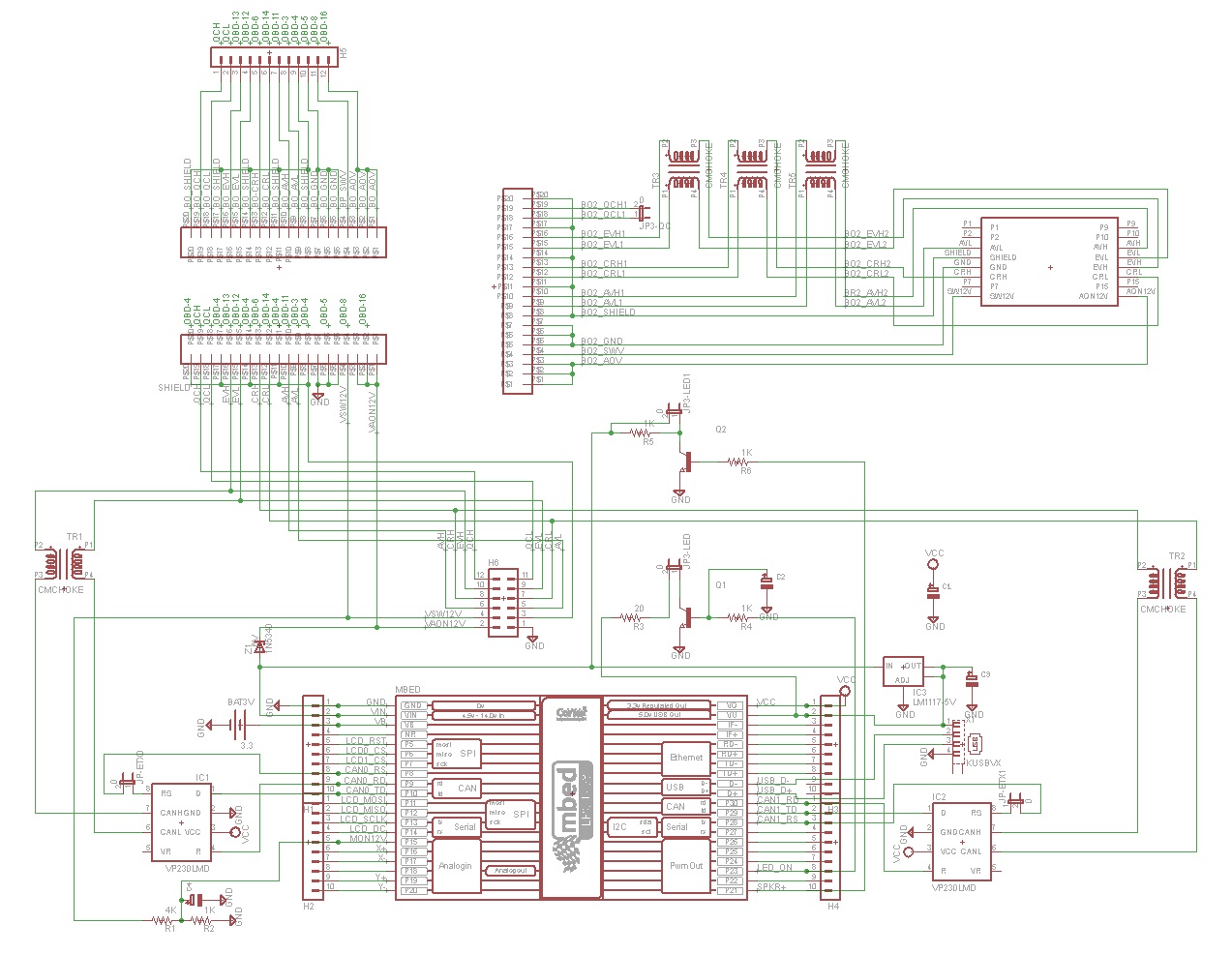
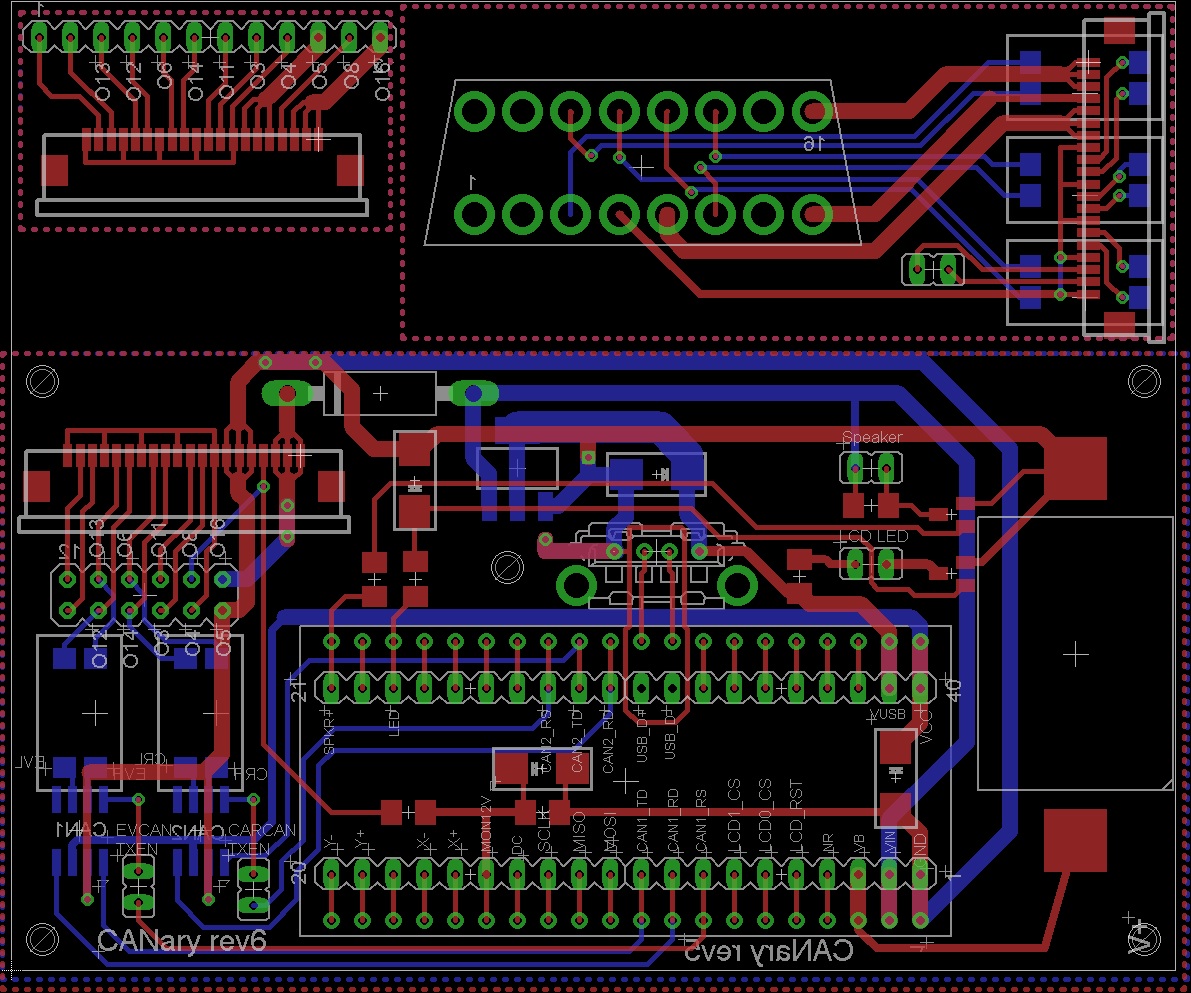
For LCD Rev 1.01:
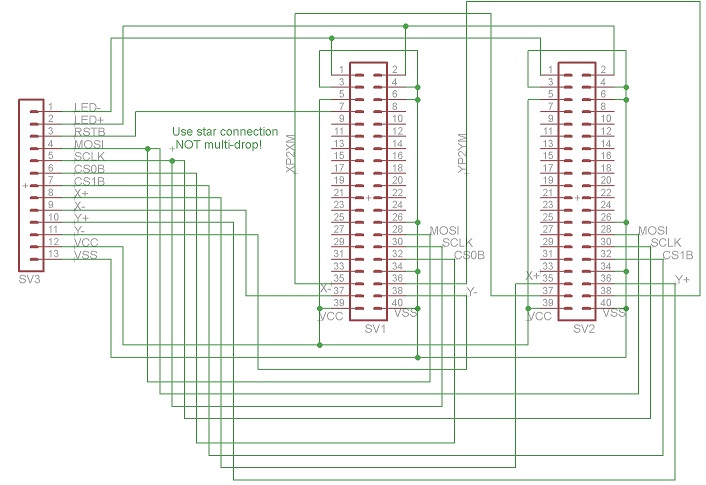
For VCD Rev 2.00:
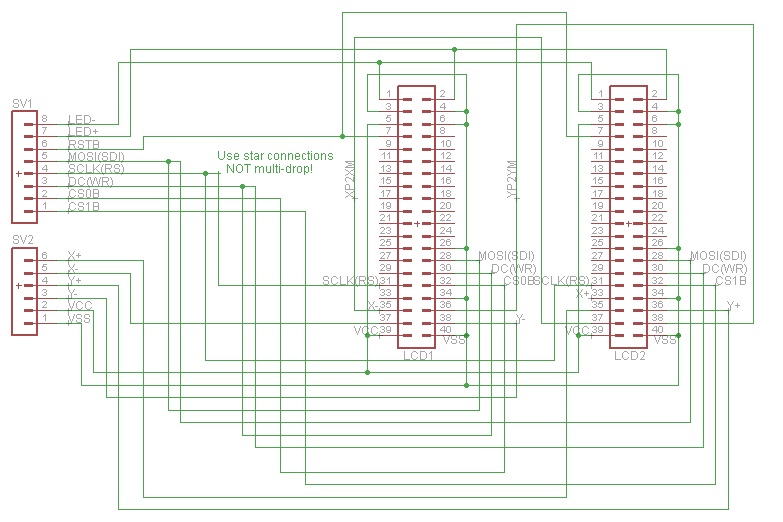
Parts List
Assembly
1) LCD Displays
I found ribbon cable is a nice way to organize the wires to the displays. There are two versions of the display and each must be wired differently. The original project used HW REV. 1.01. For that version, you'll need 12 conductors and I connected them in the following order:
| 1 | LED+ |
| 2 | LED- |
| 3 | RST |
| 4 | SDI |
| 5 | WR/SCLK |
| 6 | CS |
| 7 | X+ |
| 8 | X- |
| 9 | Y+ |
| 10 | Y- |
| 11 | VDD |
| 12 | GND |
If, instead, you have HW REV 2.0, you will need 13 conductors with the following order:
| 1 | LED+ |
| 2 | LED- |
| 3 | RST |
| 4 | SDI |
| 5 | RS (SCLK) |
| 6 | WR (DC) |
| 7 | CS |
| 8 | X+ |
| 9 | X- |
| 10 | Y+ |
| 11 | Y- |
| 12 | VDD |
| 13 | GND |
First I connected all the GND connections (2 GND & IM0, IM1, IM3 for REV1.01 or 2 GND, RD, & IM0 for REV2.00). Do not connect the bottom GND until you have the ribbon cable connected. After making all the ribbon cable connections (connecting the GND of the ribbon cable to the bottom GND pad), solder the GND bar from the previous step to the back of the bottom GND connection. Finally, make a connection from the back side 3.3V pin to IM2 for REV1.01 or to IM1,IM2,&IM3 for REV2.00. Take a break and repeat for the second display.
Examples of REV1.01 boards:
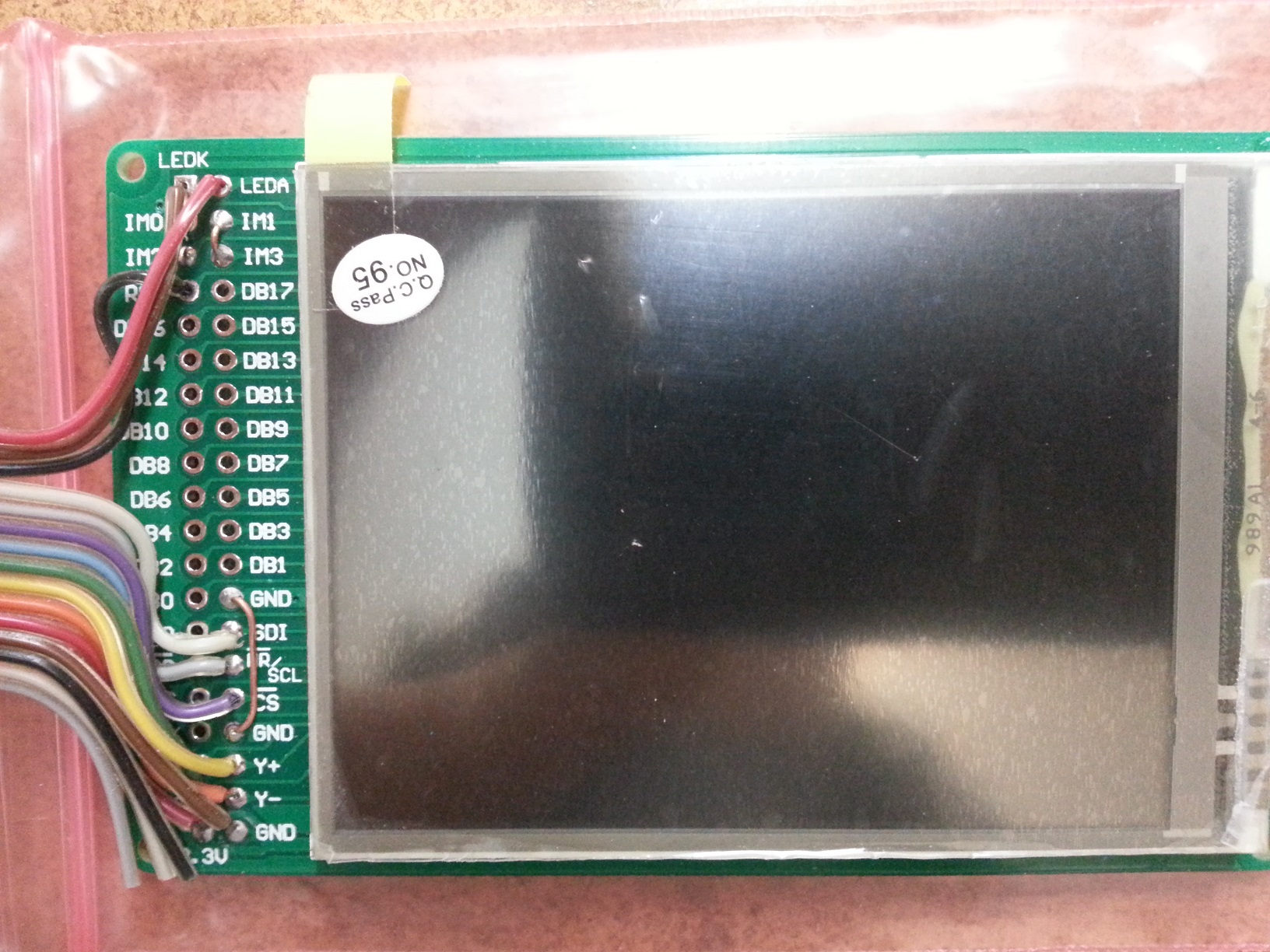
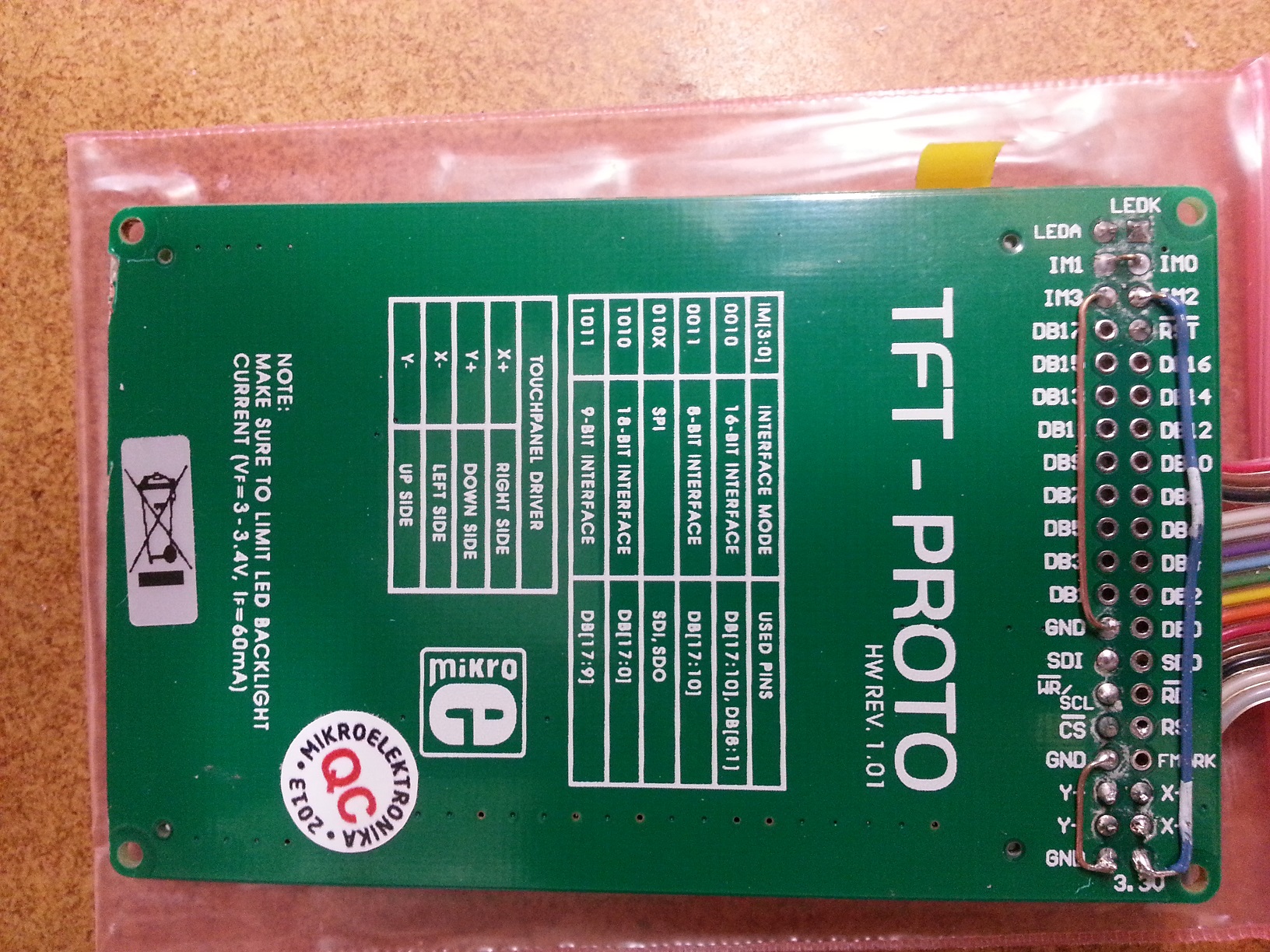
Examples of REV2.00:
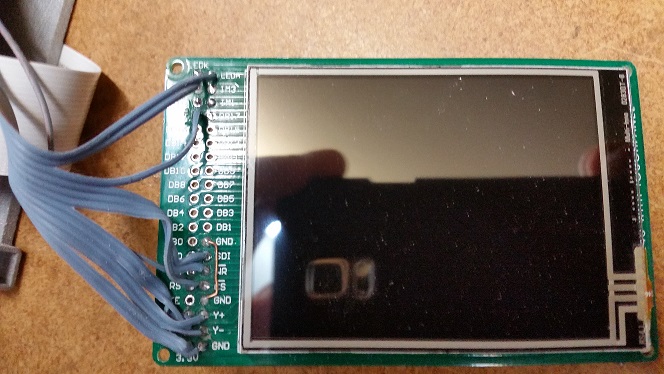

Once the two displays are complete combine all wires except CS0, CS1, X+, X-, Y+, and Y-. Connect X- of the left display to X+ of the right. Similarly connect Y- of the left display to Y+ of the right. Insulate any exposed wires.
2) PCB
Refer to the schematics to place all the components on the board. If you plan to install into the CANary 3D enclosure, DO NOT install the battery holder or the socket for the mbed and, instead, connect two wires to the VB and GND pads nearby. You will have to install the battery holder against the back wall to avoid interfering with the right-hand display and the mbed will have to be directly soldered. I have not found a socket with a low enough profile to fit in the space provided (depth of enclosure is limited by the space behind the center console). Also, I recommend keeping as much lead as possible on the Zener diode (bending it as shown to clear the back wall). Although it is operating well within parameters, the Zener gets quite hot during extended operation and the leads help dissipate the heat and keep it away from the PCB and other components.Update: Several Zeners have failed resulting in damage to some users boards so I recommend using a DC-DC converter instead to bring the 12V down to 7V.
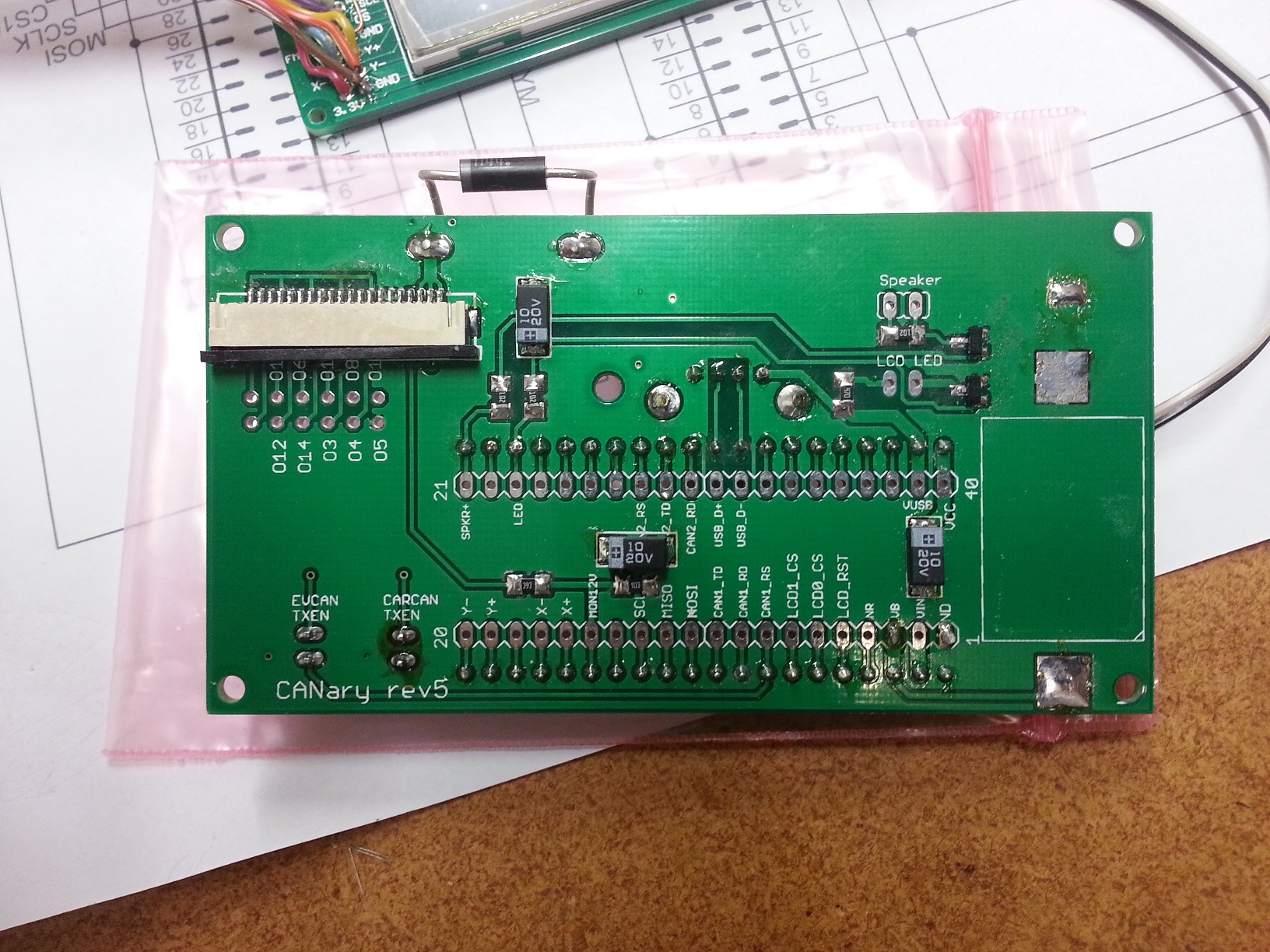
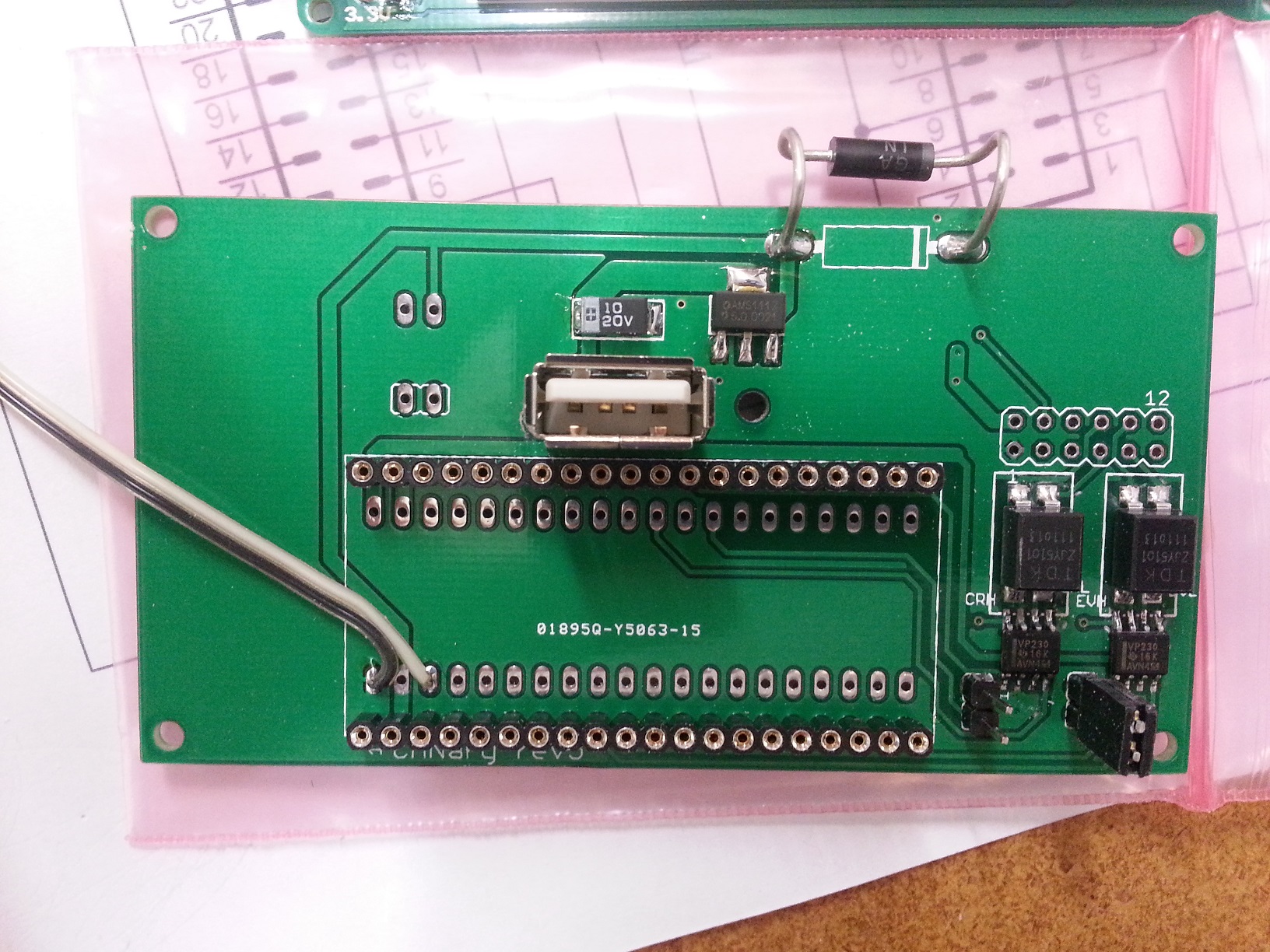
Once the PCB is populated, solder the LCDs to the PCB. CS0 connects to the right display and CS1 connects to the left.
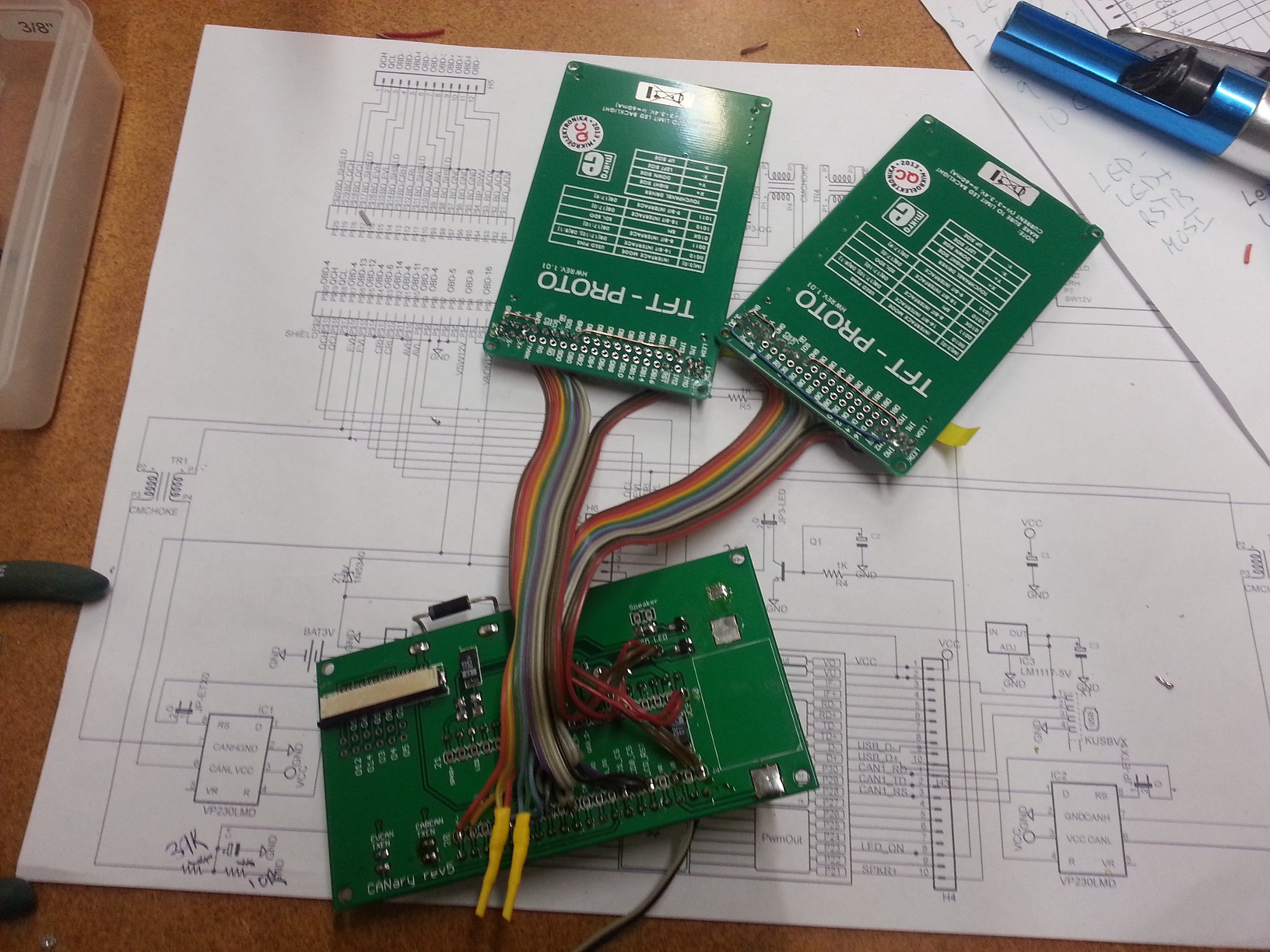
Update:
The Zener diodes tended to fail after a few months so I am recommending removing them and replacing with a DC-DC converter. This will run cooler and waste less energy, too. To install, remove the left display panel to gain access to the Zener. From there, the Zener can be removed and it's pads used to connect to the DC-DC converter. I recommend setting the output voltage on the bench before installing since the trim pot is tricky to reach once installed. Set it to 7V. The input can be connected to the left pad previously occupied by the zener and the output can connect to the right. GND(-) can be connected to the bottom right pad on the 2x6 header below the flex cable connector. Make sure the GND wire lies flat so it doesn't interfere with the connection of the flex cable.
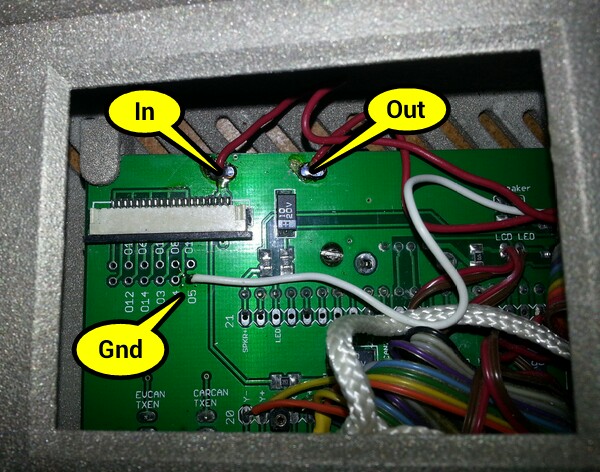
Once soldered in place, the DC-DC converter can easily be mounted to the back wall with double sided tape above the battery holder.
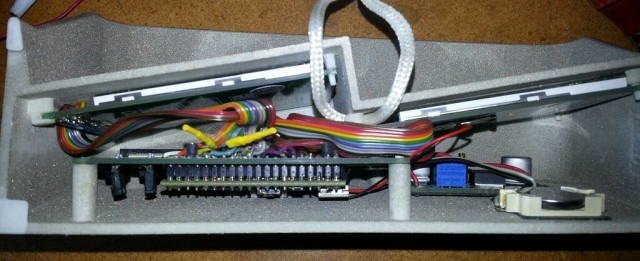
3) Testing
| 1) | First step is to buzz out all connections from the LCDs to the pins in the main board |
| 2) | Next check the touch screen connections. On the main board, place an Ohm meter across X+ and X-. You should read 700 Ohms. Repeat for Y+ and Y-. Then test the resistance from X+ to Y+. With nothing touching the screens, it should read >100K Ohms and <1K when touching either screen. |
| 3) | When all connections are checked, solder in the mbed. Download and install the touch2 program http://mbed.org/users/TickTock/code/touch2/ to test the basic operation of the mbed and touch screens. |
| tips: | |
| Touch screen is sensitive - excess flux on X+,X-,Y+,Y- connection on mbed can result in flakey operation | |
| If touch is not working, double-check the LCD0_CS and LCD1_CS are not swapped. LCD0_CS must connect to the CS of the LCD that has X- & Y- connected to the mbed. LCD1_CS must connect to the CS of the LCD that has X+ & Y+ connected to the mbed. | |
| 4) | Once touch2 works, it is time to connect to the OBD connector. I highly recommend double checking all connections from the OBD to the PCB with the cable in place before connecting to the Leaf. Buzz out all the pins in the OBS to make sure none are shorting to each other, Check that the 12V goes to the Zener (and nothing else) and the switched 12V to the resistor divider (and nothing else). Test the ground connection properly connects to ground and nothing else. |
| 5) | Once you are confident there are no shorts or wrong connections from the OBD connector, take a deep breath and plug it into your leaf. Touch2 program should come up and function. Unplug and install the latest CANary firmware. If you have the REV2.00 LCD boards, you will need to edit the precompile.h file in the TOUCH_TFTx2_w9341 library and set USE_ILI9341 to 1. Test all features before installing into the enclosure (gids, cellpair, menu system, logging) since installing and removing from the enclosure is a PITA. |
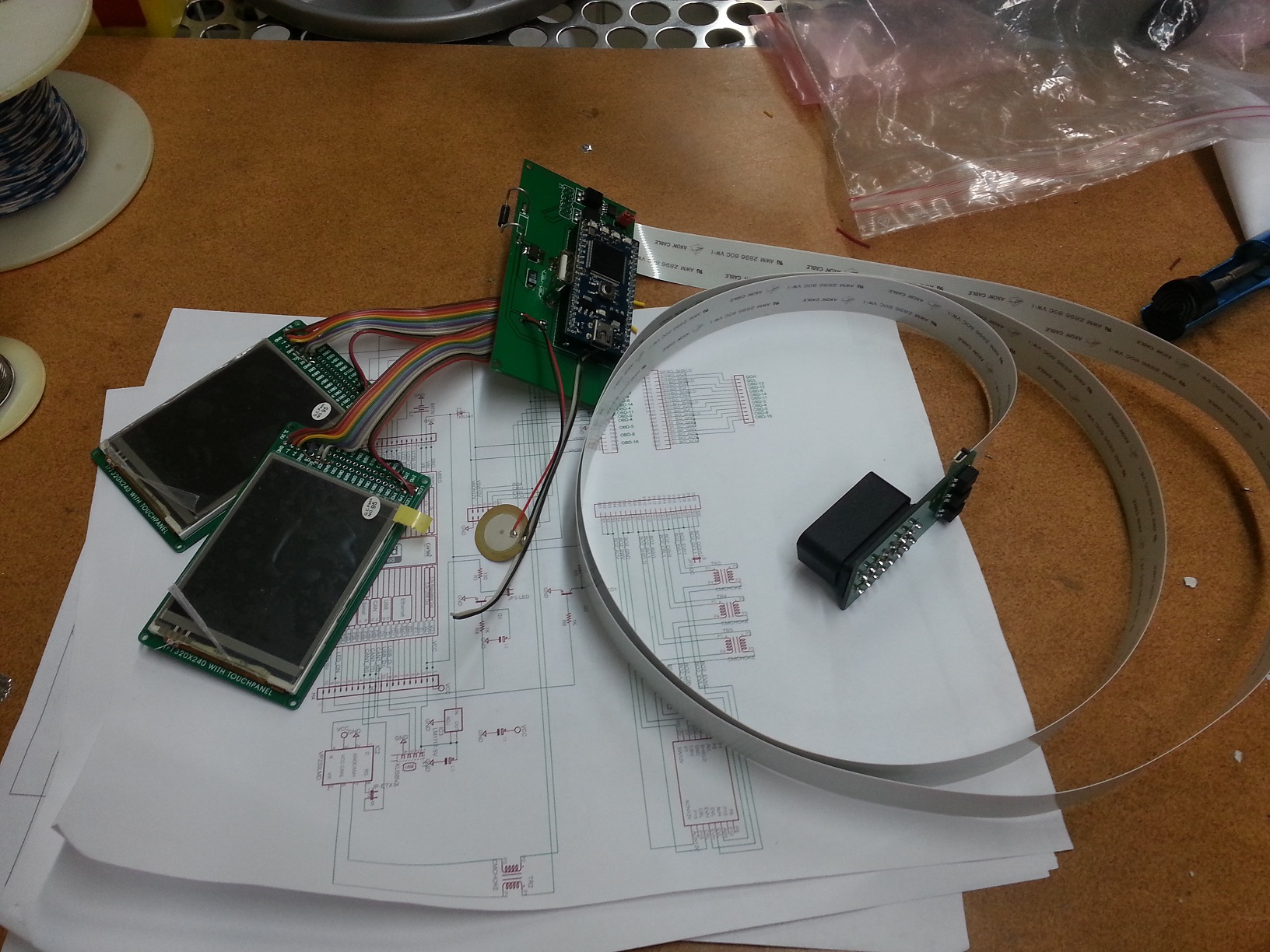
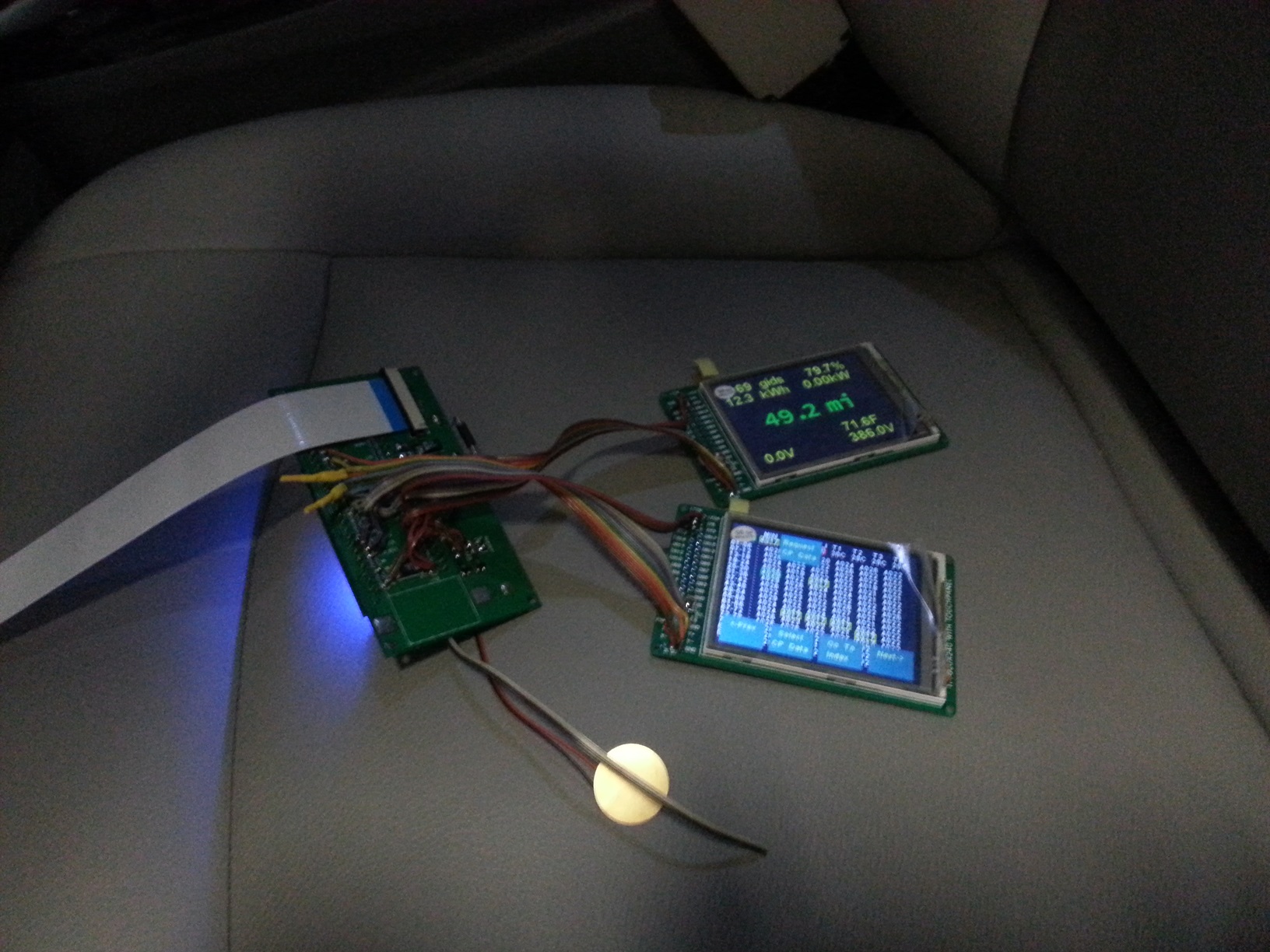
4) Enclosure
The 3D printer leaves a lot of powder behind - I used a strong spray of water to get it out of all the cracks. The enclosure comes with a rather rough finish. I recommend convincing yourself you like it, then simply lightly sand then paint before assembly. Sanding is very difficult - the nylon is very nicely fused and doesn't want to sand. I tried sandblasting and that didn't work either. I had some limited success with filler and then sanding, but only on the outside - it is too difficult to sand the face.

5) Final Assembly
Make sure you are well rested with lots of patience before attempting assembly. It is a puzzle figuring out how to get both displays and the PCB in place. Enclosure was too expensive for me to keep iterating to optimize for assembly. I ended up snipping the thin display posts shorter and using various tools to push the displays into place. Also, some USB connectors are taller than others. If you have one of the taller ones, you will have to deflect the back wall a bit while inserting the PCB (being careful not to bend the housing) to get it to it's opening in the back wall. Do use a screw in the provided post to secure the PCB as USB insertion will otherwise dislodge it.
I added an additional safety line which wraps around the center post to prevent the enclosure from becoming a projectile in the event of an accident.
 Installed:
Installed:

USBHostLite/usbhost_lpc17xx.h
- Committer:
- TickTock
- Date:
- 2015-07-01
- Revision:
- 208:bfb6b68d1677
- Parent:
- 146:88f7bda79d8e
File content as of revision 208:bfb6b68d1677:
/*
**************************************************************************************************************
* NXP USB Host Stack
*
* (c) Copyright 2008, NXP SemiConductors
* (c) Copyright 2008, OnChip Technologies LLC
* All Rights Reserved
*
* www.nxp.com
* www.onchiptech.com
*
* File : usbhost_lpc17xx.h
* Programmer(s) : Ravikanth.P
* Version :
*
**************************************************************************************************************
*/
#ifndef USBHOST_LPC17xx_H
#define USBHOST_LPC17xx_H
/*
**************************************************************************************************************
* INCLUDE HEADER FILES
**************************************************************************************************************
*/
#include "usbhost_inc.h"
/*
**************************************************************************************************************
* PRINT CONFIGURATION
**************************************************************************************************************
*/
#define PRINT_ENABLE 0
#if PRINT_ENABLE
#define PRINT_Log(...) printf(__VA_ARGS__)
#define PRINT_Err(rc) printf("ERROR: In %s at Line %u - rc = %d\n", __FUNCTION__, __LINE__, rc)
#else
#define PRINT_Log(...) do {} while(0)
#define PRINT_Err(rc) do {} while(0)
#endif
/*
**************************************************************************************************************
* GENERAL DEFINITIONS
**************************************************************************************************************
*/
#define DESC_LENGTH(x) x[0]
#define DESC_TYPE(x) x[1]
#define HOST_GET_DESCRIPTOR(descType, descIndex, data, length) \
Host_CtrlRecv(USB_DEVICE_TO_HOST | USB_RECIPIENT_DEVICE, GET_DESCRIPTOR, \
(descType << 8)|(descIndex), 0, length, data)
#define HOST_SET_ADDRESS(new_addr) \
Host_CtrlSend(USB_HOST_TO_DEVICE | USB_RECIPIENT_DEVICE, SET_ADDRESS, \
new_addr, 0, 0, NULL)
#define USBH_SET_CONFIGURATION(configNum) \
Host_CtrlSend(USB_HOST_TO_DEVICE | USB_RECIPIENT_DEVICE, SET_CONFIGURATION, \
configNum, 0, 0, NULL)
#define USBH_SET_INTERFACE(ifNum, altNum) \
Host_CtrlSend(USB_HOST_TO_DEVICE | USB_RECIPIENT_INTERFACE, SET_INTERFACE, \
altNum, ifNum, 0, NULL)
/*
**************************************************************************************************************
* OHCI OPERATIONAL REGISTER FIELD DEFINITIONS
**************************************************************************************************************
*/
/* ------------------ HcControl Register --------------------- */
#define OR_CONTROL_CLE 0x00000010
#define OR_CONTROL_BLE 0x00000020
#define OR_CONTROL_HCFS 0x000000C0
#define OR_CONTROL_HC_OPER 0x00000080
/* ----------------- HcCommandStatus Register ----------------- */
#define OR_CMD_STATUS_HCR 0x00000001
#define OR_CMD_STATUS_CLF 0x00000002
#define OR_CMD_STATUS_BLF 0x00000004
/* --------------- HcInterruptStatus Register ----------------- */
#define OR_INTR_STATUS_WDH 0x00000002
#define OR_INTR_STATUS_RHSC 0x00000040
/* --------------- HcInterruptEnable Register ----------------- */
#define OR_INTR_ENABLE_WDH 0x00000002
#define OR_INTR_ENABLE_RHSC 0x00000040
#define OR_INTR_ENABLE_MIE 0x80000000
/* ---------------- HcRhDescriptorA Register ------------------ */
#define OR_RH_STATUS_LPSC 0x00010000
#define OR_RH_STATUS_DRWE 0x00008000
/* -------------- HcRhPortStatus[1:NDP] Register -------------- */
#define OR_RH_PORT_CCS 0x00000001
#define OR_RH_PORT_PRS 0x00000010
#define OR_RH_PORT_CSC 0x00010000
#define OR_RH_PORT_PRSC 0x00100000
/*
**************************************************************************************************************
* FRAME INTERVAL
**************************************************************************************************************
*/
#define FI 0x2EDF /* 12000 bits per frame (-1) */
#define DEFAULT_FMINTERVAL ((((6 * (FI - 210)) / 7) << 16) | FI)
/*
**************************************************************************************************************
* TRANSFER DESCRIPTOR CONTROL FIELDS
**************************************************************************************************************
*/
#define TD_ROUNDING (USB_INT32U) (0x00040000) /* Buffer Rounding */
#define TD_SETUP (USB_INT32U)(0) /* Direction of Setup Packet */
#define TD_IN (USB_INT32U)(0x00100000) /* Direction In */
#define TD_OUT (USB_INT32U)(0x00080000) /* Direction Out */
#define TD_DELAY_INT(x) (USB_INT32U)((x) << 21) /* Delay Interrupt */
#define TD_TOGGLE_0 (USB_INT32U)(0x02000000) /* Toggle 0 */
#define TD_TOGGLE_1 (USB_INT32U)(0x03000000) /* Toggle 1 */
#define TD_CC (USB_INT32U)(0xF0000000) /* Completion Code */
/*
**************************************************************************************************************
* USB STANDARD REQUEST DEFINITIONS
**************************************************************************************************************
*/
#define USB_DESCRIPTOR_TYPE_DEVICE 1
#define USB_DESCRIPTOR_TYPE_CONFIGURATION 2
#define USB_DESCRIPTOR_TYPE_INTERFACE 4
#define USB_DESCRIPTOR_TYPE_ENDPOINT 5
/* ----------- Control RequestType Fields ----------- */
#define USB_DEVICE_TO_HOST 0x80
#define USB_HOST_TO_DEVICE 0x00
#define USB_REQUEST_TYPE_CLASS 0x20
#define USB_RECIPIENT_DEVICE 0x00
#define USB_RECIPIENT_INTERFACE 0x01
/* -------------- USB Standard Requests -------------- */
#define SET_ADDRESS 5
#define GET_DESCRIPTOR 6
#define SET_CONFIGURATION 9
#define SET_INTERFACE 11
/*
**************************************************************************************************************
* TYPE DEFINITIONS
**************************************************************************************************************
*/
typedef struct hcEd { /* ----------- HostController EndPoint Descriptor ------------- */
volatile USB_INT32U Control; /* Endpoint descriptor control */
volatile USB_INT32U TailTd; /* Physical address of tail in Transfer descriptor list */
volatile USB_INT32U HeadTd; /* Physcial address of head in Transfer descriptor list */
volatile USB_INT32U Next; /* Physical address of next Endpoint descriptor */
} HCED;
typedef struct hcTd { /* ------------ HostController Transfer Descriptor ------------ */
volatile USB_INT32U Control; /* Transfer descriptor control */
volatile USB_INT32U CurrBufPtr; /* Physical address of current buffer pointer */
volatile USB_INT32U Next; /* Physical pointer to next Transfer Descriptor */
volatile USB_INT32U BufEnd; /* Physical address of end of buffer */
} HCTD;
typedef struct hcca { /* ----------- Host Controller Communication Area ------------ */
volatile USB_INT32U IntTable[32]; /* Interrupt Table */
volatile USB_INT32U FrameNumber; /* Frame Number */
volatile USB_INT32U DoneHead; /* Done Head */
volatile USB_INT08U Reserved[116]; /* Reserved for future use */
volatile USB_INT08U Unknown[4]; /* Unused */
} HCCA;
/*
**************************************************************************************************************
* EXTERN DECLARATIONS
**************************************************************************************************************
*/
extern volatile HCED *EDBulkIn; /* BulkIn endpoint descriptor structure */
extern volatile HCED *EDBulkOut; /* BulkOut endpoint descriptor structure */
extern volatile HCTD *TDHead; /* Head transfer descriptor structure */
extern volatile HCTD *TDTail; /* Tail transfer descriptor structure */
extern volatile USB_INT08U *TDBuffer; /* Current Buffer Pointer of transfer descriptor */
/*
**************************************************************************************************************
* FUNCTION PROTOTYPES
**************************************************************************************************************
*/
void Host_Init (void);
extern "C" void USB_IRQHandler(void) __irq;
USB_INT32S Host_EnumDev (void);
USB_INT32S Host_ProcessTD(volatile HCED *ed,
volatile USB_INT32U token,
volatile USB_INT08U *buffer,
USB_INT32U buffer_len);
void Host_DelayUS ( USB_INT32U delay);
void Host_DelayMS ( USB_INT32U delay);
void Host_TDInit (volatile HCTD *td);
void Host_EDInit (volatile HCED *ed);
void Host_HCCAInit (volatile HCCA *hcca);
USB_INT32S Host_CtrlRecv ( USB_INT08U bm_request_type,
USB_INT08U b_request,
USB_INT16U w_value,
USB_INT16U w_index,
USB_INT16U w_length,
volatile USB_INT08U *buffer);
USB_INT32S Host_CtrlSend ( USB_INT08U bm_request_type,
USB_INT08U b_request,
USB_INT16U w_value,
USB_INT16U w_index,
USB_INT16U w_length,
volatile USB_INT08U *buffer);
void Host_FillSetup( USB_INT08U bm_request_type,
USB_INT08U b_request,
USB_INT16U w_value,
USB_INT16U w_index,
USB_INT16U w_length);
void Host_WDHWait (void);
USB_INT32U ReadLE32U (volatile USB_INT08U *pmem);
void WriteLE32U (volatile USB_INT08U *pmem,
USB_INT32U val);
USB_INT16U ReadLE16U (volatile USB_INT08U *pmem);
void WriteLE16U (volatile USB_INT08U *pmem,
USB_INT16U val);
USB_INT32U ReadBE32U (volatile USB_INT08U *pmem);
void WriteBE32U (volatile USB_INT08U *pmem,
USB_INT32U val);
USB_INT16U ReadBE16U (volatile USB_INT08U *pmem);
void WriteBE16U (volatile USB_INT08U *pmem,
USB_INT16U val);
#endif
